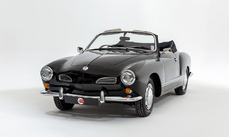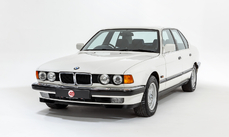Mercedes-Benz G-wagon AMG 1997
General description :
Model History
The Mercedes-Benz G-Class, sometimes called the G-Wagen (short for Geländewagen – meaning “terrain vehicle”), is characterised by its boxy styling and body-on-frame construction. It uses three fully-locking differentials and is one of the few production vehicles to have such a feature. Despite the introduction of an intended replacement in 2006, the GL-Class, the G-Class remains in production to this day and is one of the longest produced vehicles in Daimler's history, with a span of 40 years – only the Unimog surpasses it.
Development of the G-Class started in 1972 with a cooperative agreement between Daimler-Benz and Steyr-Daimler-Puch in Graz, Austria. Mercedes-Benz engineers in Stuttgart were in charge of design and testing, while the team in Graz developed the production plans. Construction commenced in Graz, where the new cross-country vehicle would be assembled nearly entirely by hand in 1975, with production of the “G Model” beginning in Graz in 1979.
The first major refinements were introduced in 1981. These included an automatic transmission, air conditioning, an auxiliary fuel tank, protective headlamp grilles, and a cable winch. Fuel injection became available in 1982, when the 230GE was introduced in Turin, along with more comfortable and supportive front seats, auxiliary heating, wider tires and flared arches. For 1985, differential locks, central door locking, and a tachometer became standard, and by 1986 over 50,000 G models had been produced.
For 1990, the G-Class (W460/W461 chassis) was extensively revised, and a new chassis number – W463 – was assigned. The W463 moved the G-Class from a solely utilitarian vehicle to the luxury model we know today. Resultantly, no three-door panel vans or “barn door” variants were offered for W463; those features were exclusive to the W461.
The 1990 facelift included several exterior revisions for a more modern aesthetic. These features included a smoother front end with body-coloured headlamp bezels and grille, a form-fitted front bumper with integrated fog lamps, body-coloured wheel arch flares, the addition of a fuel filler flap, and revised rear lights. The interior was also significantly updated with wood trim and could be specified with leather upholstery for the first time. The centre console was smoothened out and better integrated with the dashboard, the electric differential lock switches were placed prominently in the middle of dash, and the instrument cluster met the dashboard more fluidly. The climate control panel was also revised to include the temperature and fan speed dials, and the seats were plusher with several defined cushions and lumbar support.
Equipment
Smoke Silver Metallic paintwork, Black leather upholstery, 4-speed automatic transmission, 16-inch AMG alloy wheels, 4-wheel drive, Air conditioning, Electric sunroof, Heated and electrically-adjustable front seats, Electric windows, Electric door mirrors, Burred walnut interior trim, Individual front armrests, CD player, Body-coloured exterior trim, Body-coloured spare wheel cover, Side steps, Front fog lights, Bull bar, AMG badging, AMG side exit exhaust.
Exterior
Sporting colour-coded bumpers, wheel arch flares, mirror casings, side steps and rubbing strips, this long-wheelbase G36 really looks the part. The Smoke Silver paintwork retains a deep and uniform shine throughout and, while a few small blisters have begun to show through in a handful of places, the overall appearance is very presentable indeed. The bumpers front and rear are without any major scrapes or scuffs, and the car is nice and straight along both sides.
VIEWINGS WELCOME BY APPOINTMENT ONLY /// ADDITIONAL PHOTOS AVAILABLE UPON REQUEST
Interior
The interior boasts full black leather upholstery, all in superb condition throughout. The front seats are heated and electrically-adjustable and further benefit from individual folding armrests, again both in superb order. Other commonly worn items such as the steering wheel and gear selector show few signs of wear, and glancing across the dash you’ll find glossy walnut trim and switchgear that still feels reassuringly solid to operate. The carpets are also in excellent unworn condition and are protected in the footwells by a set of genuine Mercedes mats. The rear seats are in equally fine order and the vast boot area is also very tidy.
ENGINE & TRANSMISSION
The 3.6-litre M104 straight six starts first turn of the key and idles up to temperature without fuss. It’s paired with a four-speed automatic transmission that’s still very smooth on test, handling the engine’s power perfectly through the gears. On arrival from Japan earlier this year the car was treated to a full service and general shakedown in preparation for sale, the invoice for this work alone totalling in excess of £3,900. The car further benefits from a new air mass sensor, alternator, catalytic converter, and advisory-free MOT valid until October 2022.
WHEELS, TYRES & BRAKES
The G36 sits on 16-inch AMG alloy wheels with a very smart two-tone paint finish and absolutely no curb marking to speak of; they are shod in Toyo Proxes tyres all round, each one with ample tread left. The brakes have also been checked and remain in fine operational condition having received new pads and shoes less than 100 miles ago.
History File
This rare example was supplied new to its first keeper in Japan in January 1997. Originally leaving Germany as a 320 GE, the car was later converted to a G36 by AMG in Japan, as shown by the additional AMG VIN plate in the door shut. While German-made AMGs could be imported directly into Japan, AMG also had their own facility in Japan where stock Mercedes vehicles could be modified under license of AMG.
After landing in the UK earlier this year with all taxes paid on arrival, this LHD example was fully inspected and re-commissioned as necessary. The current owner has now spent in excess of £6,000 mechanically preparing the car for sale, as documented in the accompanying paperwork. Recent work includes a full engine service, gearbox service, brake overhaul, a new air mass sensor, cat, alternator, battery, etc. Since arriving with us the car has been inspected once again and boasts a clean bill of health.
Inside the History File there is a leather AMG document wallet with all owner handbooks, a raft of Japanese maintenance documents, UK invoices totalling £6,098.51, and a fresh inspection report from our trusted classic car specialists. UK registration is currently underway.
http://www.4starclassics.com/for-sale/mercedes-g36-amg-for-sale/
1997 Mercedes-Benz G-wagon AMG is listed sold on ClassicDigest in Kingsley by 4 Star Classics for £34995.
Car Facts
Car type : Car Make : Mercedes-Benz Model : G-wagon Model Version : AMG Engine size : 3.6 Model Year : 1997 Sub type : Pick up Location : Hampshire
Sold
Seller Information
Sold
People who viewed this Mercedes-Benz G-wagon also viewed similar Mercedes-Benz listed at ClassicDigest
Other cars listed for sale by this dealer
About Mercedes-Benz
In the annals of automotive history, the journey of Mercedes-Benz is a tale that unfolds with the ingenuity of its founding pioneers. In the year 1886, Karl Benz crafted the Benz Patent Motorwagen, a creation that would go down in history as the world's inaugural automobile. Unbeknownst to him, this moment marked the genesis of what would evolve into the most illustrious premium car manufacturer globally. The financial underpinning of this pioneering venture, interestingly, was provided by Karl Benz's wife, Bertha Benz, demonstrating a remarkable partnership that would set the tone for Mercedes-Benz's legacy.A parallel narrative emerged not far away, as Daimler-Motoren-Gesellschaft, founded by Gottlieb Daimler and Wilhelm Maybach, entered the scene. In 1901, they unveiled their automobile under the now-famous moniker "Mercedes," meaning "godsend" in Spanish. This name was bestowed upon the car at the behest of Emil Jellinek's daughter, the distributor for Daimler-Motoren-Gesellschaft. The wheels of innovation were set in motion.
Fast forward to 1926, a pivotal year that witnessed the merger of Daimler with Benz & Cie., culminating in the birth of Daimler-Benz. The amalgamation saw the adoption of "Mercedes-Benz" as the distinguished trademark for their automobiles, fusing the legacies of two visionary entities into one.
Contrary to perceptions of conservatism, the trajectory of Daimler-Benz unfolds as a chronicle of industry firsts. From the introduction of the honeycomb radiator to the float carburetor, and the pioneering implementation of four-wheel brakes in 1924, Daimler-Benz consistently pushed the boundaries of automotive innovation. The diesel-powered Mercedes-Benz 260 D in 1936 marked the inception of diesel engines in passenger cars. The iconic Mercedes-Benz 300SL Gullwing made history as the first car with direct fuel injection, albeit the Gutbrod's tiny 2-stroke engine can claim precedence.
Safety innovations became a hallmark, with Béla Barényi's patented safety cell design in the "Ponton"-models in 1951, featuring front and rear crumple zones. The W116 450SEL 6.9 saw the introduction of the Anti-Lock Brake system (ABS), another pioneering safety feature. From the first production airbags and beyond, the legacy of "firsts" continued to be etched into the fabric of Daimler-Benz.
Over its centennial journey, Mercedes-Benz has not merely produced cars but has sculpted automotive icons. The SSKL, 710 SSK Trossi Roadster, 770K Grosser, 540K Spezial Roadster, 300SL Gullwing, w100 600 Pullman, w111 280SE 3.5 Flachkühler, w113 230SL Pagoda, w109 300 SEL 6.3, and w201 2.3-16 Cosworth stand testament to the brand's commitment to engineering excellence.
The roaring Silver Arrows, or "Silberpfeile," including the W 25, W 125, W154, W165, and W196, created a legacy of dominance on the racetrack. These machines were not merely cars; they were expressions of precision, speed, and an indomitable spirit that left their competitors in the dust.
As Mercedes-Benz marches into the future, it does so not just as an automaker but as a custodian of a legacy, a torchbearer of innovation, and a beacon of automotive excellence. The road ahead is sure to witness the continued fusion of cutting-edge technology, timeless design, and an unwavering commitment to setting new standards in the world of automobiles.
One luminary figure who left an indelible mark was Béla Barényi, often heralded as the "father of passive safety" for his pioneering work in safety engineering. His patented safety cell design, featuring front and rear crumple zones, became a hallmark of Mercedes-Benz's commitment to occupant safety, setting new standards that reverberated throughout the automotive world.
Moving through the chronicles, the collaborative genius of Wilhelm Maybach, alongside Gottlieb Daimler, laid the foundation for Daimler-Motoren-Gesellschaft. Their innovations not only birthed the first Mercedes but established a culture of relentless pursuit of technological excellence that remains integral to Mercedes-Benz's DNA.
In the post-merger era of 1926, Ferdinand Porsche emerged as a prominent figure within Mercedes-Benz. His work on the Mercedes-Benz S-Type, a supercharged race car, garnered acclaim and set the stage for a legacy that extended far beyond the marque. Porsche's impact would later extend to his eponymous company, but his influence at Mercedes-Benz during those formative years was pivotal.
As the 20th century progressed, the legendary Rudolf Uhlenhaut emerged as a key figure. Uhlenhaut, an accomplished engineer and the driving force behind the iconic Silver Arrows, played a crucial role in Mercedes-Benz's dominance in motorsports. His engineering prowess and attention to detail were instrumental in creating some of the most formidable racing cars of the era.
In the latter half of the century, figures like Bruno Sacco, the head of design at Mercedes-Benz from 1975 to 1999, left an indelible imprint on the brand's aesthetic identity. Sacco's design philosophy, characterized by clean lines and timeless elegance, shaped iconic models like the W126 S-Class and the W201 190E, solidifying Mercedes-Benz's reputation for luxury and sophistication.
The narrative would be incomplete without acknowledging the contributions of engineers like Hans Scherenberg, whose leadership in the 1970s ushered in a new era of technological innovation at Mercedes-Benz. Scherenberg's tenure saw the development of groundbreaking technologies, including the Anti-Lock Brake system (ABS) and the introduction of airbags in production cars.

























